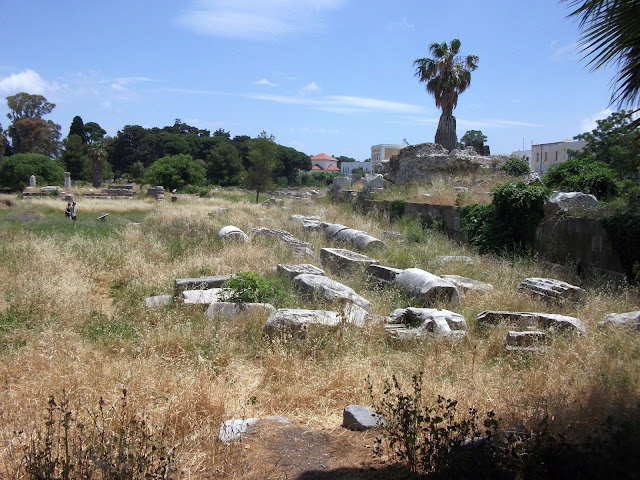This article (without the images) on Kos
past and present appears in full in Scottish Review
Spending
a few days on the Greek island of Kos has involved seeing a lot of
ruins. The main one was the Asklepeion, a temple dating from the
fourth century BC where healing and medicine were practised by
Hippocrates among others. There are several Asklepeia in Greece,
named after Asklepios the God (or demi-god to be precise) of healing
dreams, and this is one of the largest ones. People would travel long
distances to these temples and after ablutions, fasting and prayer to
Asklepios, would spend the night there, hoping for a dream that would
indicate a cure for their illness.
 |
| Steps up to the Asklepeion |
Other
ruins and mosaics were in the Western Excavations near the Odeon.
And the ruins of the Ancient Agora, in Kos town centre, close to the
harbour. This is a vast excavation area, including a lot more than a
marketplace. The oldest parts date from the 3rd
century BC and there are the remains of a shrine to Aphrodite and a
later Christian Basilica dating from the 5th century.
Once again,
lying on the ground are massive stone pillars broken into pieces, and
beautifully carved capitals. What is more startling is to come across
mosaics, half hidden by the long grass. These are mostly fragments
but there is one complete one of a rather pensive looking bird.
What
strikes me about these stone ruins is that they don’t seem to have
aged at all. Perhaps it’s the quality of the stone or the dryness
of the atmosphere or both, but these stones look as though they could
have been thrown there just a few years ago. They’re surrounded by
long dried grasses and prickly plants that scratch your legs as you
walk through them – though some paths have been worn by numerous
feet – and colourful wild flowers dotted among the grass. The dense
growth of these fearsomely sharp and spiny yellow stalks are nothing
like the feathery soft green vegetation that we call grass.
After
admiring all these broken and scattered stone remains and braving the
scratchy undergrowth, all in hot sunshine, I felt it was time to
increase my knowledge in the cool interior of the Archaeological
Museum in Plateia Eleftherias in Kos town centre.
 |
| platia Eleftherias, Kos town |
But
when I reached the outer gates of this building there was a
handwritten note pinned to them, in Greek and English, saying that it
was closed today (17th
May) because of a national strike. As I walked away I noticed a small
crowd gathering in the square just opposite the Museum....
You can read the rest of this article here









Comments
Beautiful mosaics....lovely warm colours!
Rubyxx
M xx